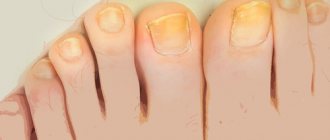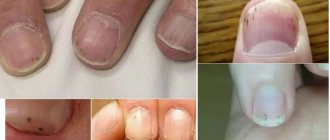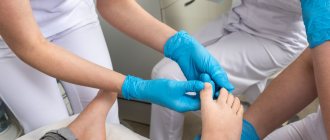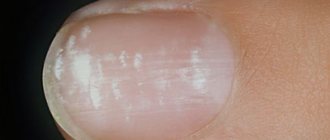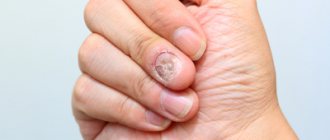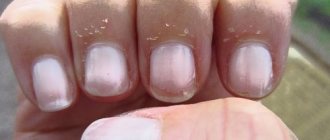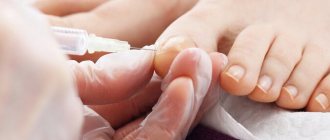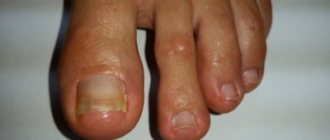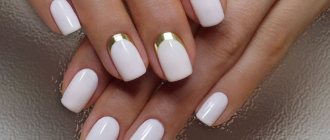Onychorrhexis (ICD code L 60.3) is a type of dystrophy of the nail plate in which it splits along the direction from the free edge to the growth zone. Occurs in women and men. Depending on the cause, onychorrhexis is observed only on one nail or on all of them at once. Cracks can be single or multiple, of different lengths and depths.
What causes?
The causes of onychorrhexis are divided into internal and external. When the body weakens, chronic pathologies, infections, the nail initially grows fragile. It cracks easily, delaminates, breaks off from the free edge. Due to impaired blood flow and chronic diseases, longitudinal splitting of the nail is often found in older people. The older the person, the higher the risks. Aging of the body is the most common reason.
Internal factors include:
- diabetes, thyrotoxicosis, cause metabolic disorders;
- atherosclerosis, lead to a decrease in the lumen of blood vessels, a decrease in blood flow, and the supply of nutrients;
- eczema, psoriasis, cause inflammation, disruption of the nail structure;
- autoimmune diseases (Raynaud's syndrome, vasculitis), damage the walls of blood vessels, nutrition of the matrix, reduce the strength of the resulting plate;
- lack of vitamins and minerals in the body due to malnutrition, eating disorders (anorexia, bulimia) or gastrointestinal diseases that interfere with the absorption of nutrients and change the chemical composition of the plate;
- fungal infection, provokes an inflammatory process, destroys the healthy structure of the nail;
- tumor diseases.
External factors can cause dystrophy:
- injuries received during a manicure or pedicure;
- household damage;
- working with cleaning agents and detergents without protective gloves;
- wearing shoes that don't fit;
- features of the profession: working at a computer with nails tapping on the keyboard, or playing the piano;
- continuous wearing of gel polish or artificial coverings;
- using acetone-based nail polish removers;
- habit of biting nails;
- frequent contact with water, alcohol, solvents, chemicals that dry out and damage the plate;
- Excessive length, improper cutting of nails.
In children, onychorrhexis is caused by trauma, decreased immunity, and previous infectious diseases.
Causes
There may be several factors influencing poor nail condition and cracking. Cracks are symptoms of various diseases, the result of exposure to aggressive environmental factors.
External influence
The horny covering on the fingertips has a protective function.
When impacted, pinched, or exposed to aggressive substances, it is destroyed, fractures and cracks appear. When working in unfavorable conditions, in water, without protective gloves, the risk of injury to the nail increases.
Lack of nutrients
At the end of winter and spring, the body experiences a lack of vitamins and microelements. This affects the deterioration of the condition of the nails: they become thinner, split, and crack.
During these seasons, foods rich in proteins, calcium, and magnesium are introduced into the diet:
- meat;
- milk and products made from it;
- nuts;
- sunflower seeds;
- orange fruits;
- greenery.
Vitamin complexes designed to strengthen tissues are used.
Nail diseases
Fungus is the main cause of diseases of the stratum corneum. In advanced cases, it destroys the nail to the ground .
It may be impossible to restore the plate using a conservative method; the problem is solved promptly.
The first symptoms of a fungal disease: itching of the skin, dryness, peeling, discoloration of the nail, and the appearance of cracks.
Diseases such as psoriasis and eczema can affect the condition of the plate.
Physiological reasons
Birth defects occur. From an early age, a person suffers from fragility and delamination of the stratum corneum. In adulthood, cracks appear, which are quite difficult to treat.
The reason for this condition is a genetic predisposition to deformation and diseases of the horny plate.
Hormonal changes often occur in women during pregnancy or menopause. This affects the quality and condition of the stratum corneum.
Diabetes mellitus is a disease in which metabolic processes are disrupted, which leads to deterioration of the nails.
Poor nutrition
An incorrectly composed diet leads not only to a deterioration in overall health, but also to cosmetic defects.
Thin, split, brittle nails are the result of poor nutrition. If the situation is not brought under control, over time, cracks will appear on the nails due to a lack of microelements.
Dehydration can cause nail defects. All body tissues and the stratum corneum are saturated with moisture. Its deficiency causes dryness, brittleness, and the appearance of cracks.
What are the symptoms?
The main sign is the presence of longitudinal cracks on the plate, running from the free edge to the center or base of the nail. They look like grooves or furrows. Depending on the cause, there may be one or several cracks, only on one finger or more. Onychorrhexis affects the fingernails and toenails, but is more common on the hands. On the feet, only the big toe is predominantly affected.
What onychorrhexis looks like is shown in the photo of the nail below:
In addition to longitudinal cracks, thinning of the plate, a change in color to yellowish or grayish, and an uneven laminated free edge are also possible. Due to increased fragility, longitudinal splitting is often combined with transverse splitting, which is called onychoschisis.
Vertical grooves on the nails, reminiscent of onychorrhexis, are characteristic of trachyonychia. And their treatment principles are similar. This is a type of onychodystrophy in which the nails become dull, rough, and covered with grooves and scales.
Repair
It will not be difficult to cope with plate deformations at home. All you need to use is clear varnish, a napkin, and a nail file. You need to use a nail file to go over the damaged plate, then brush off the dust. Apply a layer of clear varnish and let it dry. After spreading the napkin over the nail, apply the polish on top again and leave it to dry. After this, it is recommended to contact specialists if this method turns out to be useless. In cases where your toenails crack and blood is visible, you should not self-medicate. This is an indication for a serious examination.
Diagnostics
If you find a plate splitting, contact a podiatrist or dermatologist to prevent the condition from getting worse. If left untreated, the crack will grow and reach the free edge. It will divide the nail into two halves and cause detachment from the bed. In addition, violation of the integrity of the plate opens access to pathogenic pathogens and often leads to bacterial or fungal infectious complications.
The specialist will examine the structure of the plate, assess the severity of the damage, suggest how to treat onychorrhexis of the fingernails or toenails, and how to improve their appearance.
To find out the cause, he will ask the patient about chronic diseases and prescribe additional examinations:
- examination of a nail scraping for fungus;
- general blood test, sugar test;
- consultation with an endocrinologist, gastroenterologist, vascular surgeon;
- microscopic examination;
- examination with a dermatoscope at 10x magnification.
Skin diseases
When answering the question of why the skin under the nails cracks, it is also necessary to mention skin diseases. Such ailments may be non-infectious or infectious in nature. In the first case, a person develops psoriasis or eczema. As for infectious diseases, this includes fungal infections. Skin diseases provoke the formation of deep cracks under the nails, around them, between the fingers, and also on the palms.
How to treat?
To treat onychorrhexis, an integrated approach is used, aimed at eliminating the cause, normalizing metabolic processes, and strengthening the structure of the nails. If these conditions are met, treatment gives a good result. True, it takes up to six months, since the nail plate grows slowly, on average by 1 mm per week. The matrix where nails are formed is hidden under the skin of the lower roller, at a distance of 4 mm from the cuticle. It will take 4 weeks just to improve his condition, and to change the plate on his fingers it will take 4 to 6 months.
Treatment is selected depending on the severity of the injuries and the person’s health status. When identifying concomitant pathologies that cause longitudinal clefting, attention is paid to their treatment.
To strengthen nails the following is prescribed:
- massage;
- vitamins, amino acids, minerals;
- medicinal baths;
- drugs to strengthen the walls of blood vessels and improve blood circulation in the extremities;
- physiotherapy (paraffin therapy, ozokerite, mud masks).
Traditional methods and remedies for the treatment of onychorrhexis of nails include masks or baths with natural oils, oil solutions of vitamins, gelatin, as well as moisturizing and nourishing creams. They help strengthen nails and accelerate regeneration processes. But it is better to discuss the safety of their use with your doctor.
In case of deep, long cracks, the plate is reinforced with artificial materials to stabilize it.
Temperature
When considering the reasons for the appearance of such a symptom, sudden changes in temperature should also be included here. The fact is that sensitive skin reacts to frost and cold. The skin becomes dry, cracks form around the nails, as well as under them. If you do not take any measures, the wounds will become deeper and larger. They hurt a lot and cause discomfort to their owner, so during the cold season it is necessary to pay special attention to the hands.
Care and prevention
When treating onychorrhexis, as well as for its prevention in the future, it is important to properly care for the nails, skin of the hands and feet.
What rules must be followed?
- Wash dishes and use any cleaning agents or detergents only with gloves.
- For manicure, choose high-quality varnishes with a harmless composition; do not use removers containing acetone to remove nail polish.
- Avoid frequent contact with water.
- When treating onychorrhexis, it is not recommended to do a manicure or apply any coatings to the nails other than those prescribed by the doctor. In the future, take breaks from wearing gel polish and artificial nails.
- Take care of your drinking regime and a nutritious diet, including fruits, vegetables, and low-fat protein foods.
- Do not grow your nails too long; periodically get medical manicures and pedicures at podiatry centers.
- Massage your hands and feet daily, moisturize the skin on your arms and legs with nourishing creams.
As a rule, onychorrhexis does not cause pain or inflammation, but you still need to go to a podiatrist with this problem. The specialist will prescribe the correct treatment, which will speed up the recovery of the nail and prevent the development of complications. He will also tell you about the rules of care at home so that splitting or splitting of nails no longer bothers you.
13 1
Treatment of cracked nails
Lemon juice has a healing effect on nails
To keep your nails healthy, it is important to take care of them regularly. For this there are all kinds of medicinal varnishes, oils, vitamin baths . There are many nourishing and antibacterial products for nails, in particular for the treatment of cracks: Bepanten, Solcoseryl, Radevit or D-Panthenol.
A recipe based on olive oil and lemon juice if you rub this mixture in every day. Another healing remedy is a mixture of honey and glycerin with flour . This mask must be kept on for 20 minutes. Sea salt has strong regenerating properties .
If the breakage is only a one-time occurrence, it is enough to patch the crack and wait for the nail to recover.
Review your diet and give up bad habits. Consume more vitamins A, E, B, C. Add foods with calcium, iron and zinc to the menu. For complete absorption of calcium, the building material for nails, ensure adequate intake of vitamin D.
